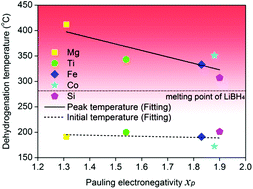Correlation between structural stability of LiBH4 and cation electronegativity in metal borides: an experimental insight for catalyst design
Abstract
Nanosized metal borides MBx (M = Mg, Ti, Fe, Si) are found to play an important role in enhancing the hydrogen storage performance of LiBH4 in this work. The hydrogen storage behavior and mechanism of these modified systems are investigated through TPD-MS, XRD, FTIR and SEM characterization methods. By introducing these metal borides into LiBH4 through ball milling, the systems display three dehydrogenation stages disclosing their similarity and distinction. The 1st stage starts at 190 °C, the 2nd stage ranges from 280 °C to 400 °C and the 3rd stage ends at 550 °C with a peak at round 440 °C similar to that of pristine LiBH4. Distinguishing features exist at the 2nd stage revealing the effectiveness of MBx in an order of MgB2 < TiB2 < FeB < SiB4. Significantly, reversibility up to 9.7 wt% is achieved from LiBH4 with assistance of SiB4. The catalytic effect of MBx is influenced by the Pauling electronegativity of M in MBx and the interfacial contact characteristic between LiBH4 and MBx. The larger electronegativity leads to an enhanced catalytic effect and consequently lower temperature at the major stage. In contrast to the components in the solid state, the molten LiBH4 promotes a catalytic effect due to a superior interfacial contact. These results provide an insight into designing high-performance catalysts applied to LiBH4 as a hydrogen storage material.



 Please wait while we load your content...
Please wait while we load your content...